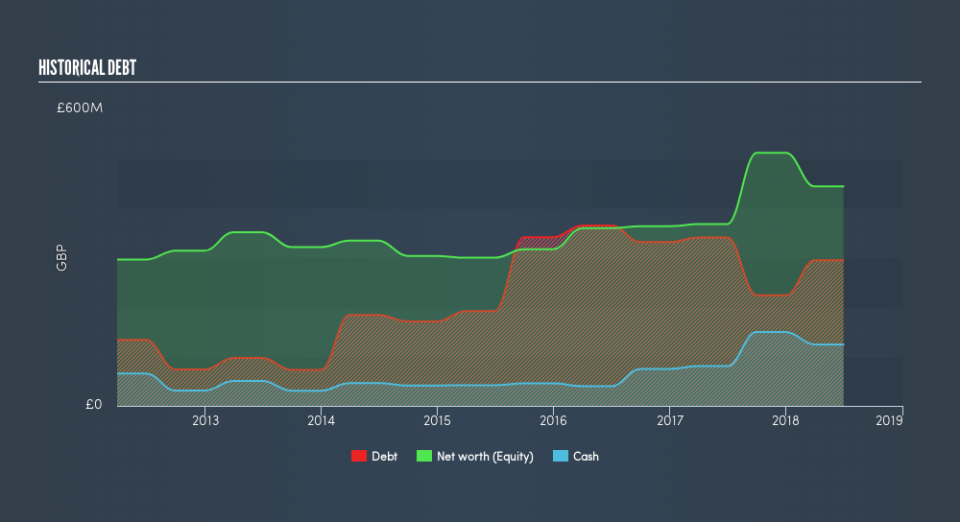Ultra Electronics Holdings plc (LON:ULE): Time For A Financial Health Check

Ultra Electronics Holdings plc (LON:ULE) is a small-cap stock with a market capitalization of UK£937m. While investors primarily focus on the growth potential and competitive landscape of the small-cap companies, they end up ignoring a key aspect, which could be the biggest threat to its existence: its financial health. Why is it important? So, understanding the company’s financial health becomes crucial, as mismanagement of capital can lead to bankruptcies, which occur at a higher rate for small-caps. I believe these basic checks tell most of the story you need to know. Though, given that I have not delve into the company-specifics, I’d encourage you to dig deeper yourself into ULE here.
How does ULE’s operating cash flow stack up against its debt?
ULE has shrunken its total debt levels in the last twelve months, from UK£341m to UK£294m , which also accounts for long term debt. With this reduction in debt, the current cash and short-term investment levels stands at UK£124m for investing into the business. Additionally, ULE has generated cash from operations of UK£73m over the same time period, resulting in an operating cash to total debt ratio of 25%, indicating that ULE’s operating cash is sufficient to cover its debt. This ratio can also be a sign of operational efficiency as an alternative to return on assets. In ULE’s case, it is able to generate 0.25x cash from its debt capital.
Can ULE meet its short-term obligations with the cash in hand?
Looking at ULE’s UK£258m in current liabilities, it appears that the company has maintained a safe level of current assets to meet its obligations, with the current ratio last standing at 1.67x. Generally, for Aerospace & Defense companies, this is a reasonable ratio since there’s a sufficient cash cushion without leaving too much capital idle or in low-earning investments.
Is ULE’s debt level acceptable?
With debt reaching 66% of equity, ULE may be thought of as relatively highly levered. This is not unusual for small-caps as debt tends to be a cheaper and faster source of funding for some businesses. We can test if ULE’s debt levels are sustainable by measuring interest payments against earnings of a company. Ideally, earnings before interest and tax (EBIT) should cover net interest by at least three times. For ULE, the ratio of 27.2x suggests that interest is comfortably covered, which means that debtors may be willing to loan the company more money, giving ULE ample headroom to grow its debt facilities.
Next Steps:
ULE’s high cash coverage means that, although its debt levels are high, the company is able to utilise its borrowings efficiently in order to generate cash flow. Since there is also no concerns around ULE’s liquidity needs, this may be its optimal capital structure for the time being. This is only a rough assessment of financial health, and I’m sure ULE has company-specific issues impacting its capital structure decisions. I recommend you continue to research Ultra Electronics Holdings to get a better picture of the small-cap by looking at:
Future Outlook: What are well-informed industry analysts predicting for ULE’s future growth? Take a look at our free research report of analyst consensus for ULE’s outlook.
Valuation: What is ULE worth today? Is the stock undervalued, even when its growth outlook is factored into its intrinsic value? The intrinsic value infographic in our free research report helps visualize whether ULE is currently mispriced by the market.
Other High-Performing Stocks: Are there other stocks that provide better prospects with proven track records? Explore our free list of these great stocks here.
We aim to bring you long-term focused research analysis driven by fundamental data. Note that our analysis may not factor in the latest price-sensitive company announcements or qualitative material.
If you spot an error that warrants correction, please contact the editor at editorial-team@simplywallst.com. This article by Simply Wall St is general in nature. It does not constitute a recommendation to buy or sell any stock, and does not take account of your objectives, or your financial situation. Simply Wall St has no position in the stocks mentioned. Thank you for reading.

 Yahoo Finance
Yahoo Finance 
